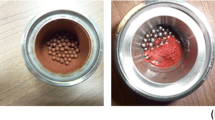Abstract
Yttrium oxide and lutetium oxide, produced via precipitation stripping from the metal-loaded organic phase of a solvent extraction process, have been analyzed for purity, particle size, and morphology. Composition and purity of the rare earth oxides were measured using laser-induced breakdown spectroscopy (LIBS) and powder X-ray diffraction. There were no differences in composition between traditionally produced oxide samples and oxide samples generated through precipitation stripping. Scanning electron microscopy (SEM) was used to investigate the particle size and morphology. The traditionally prepared oxides are composed of cubelike and rodlike particles and the oxides produced via precipitation stripping are composed of platelike particles. Both procedures produce particles with approximately the same surface area. Precipitation stripping is a viable alternative to traditional acid stripping in solvent extraction processes and can be used to produce high-purity rare earth oxides.









Similar content being viewed by others
Notes
JEOL is a trademark of Japan Electron Optics Ltd., Tokyo.
References
A.W. Sleight: Acc. Chem. Res., 1995, vol. 28, pp. 103–08
J.-C.G. Bünzli, C. Piguet: Chem. Soc. Rev., 2005, vol. 34, pp. 1046–77
H. Tsukube, S. Shinoda: Chem. Rev. 2002, vol. 102, pp. 2389–2403
C.L. Melcher: J. Nucl. Med. 2000, vol. 41, pp. 1051–55
K.L. Nash: in Handbook on the Physics and Chemistry of the Rare Earths: Vol. 18—Lanthanides/Actinides Chemistry, K.A. Gschneidner Jr., L. Eyring, G.R. Choppin, G.H. Lander, eds., Elsevier Science B.V., Oxford, United Kingdom, 1994, pp. 197–238
(a) J.H. Yoon and F.M. Doyle: in Innovations in Materials Processing Using Aqueous, Colloid, and Surface Chemistry, F.M. Doyle, S. Raghavan, P. Somasundaran, and G.W. Warren, eds., TMS, Warrendale, PA, 1988, pp. 195–211. (b) J.-C. Lee and F.M. Doyle: in Rare Earths: Resources, Science, Technology and Applications, R.G. Bautista and N. Jackson, eds., TMS, Warrendale, PA, 1991, pp. 139–51. (c) Y. Konishi, S. Asai, and T. Murai: Metall. Mater. Trans. B, 1993, vol. 24B, pp. 537–39. E. Combes, C. Sella, D Bauer, and J.L. Sabot: Hydrometallurgy, 1997, vol. 46, pp. 1–12. (d) M. Iglesias, E. Anitcó, V. Salvadó, A. Masana, and M. Valiente: Solvent Extr. Ion Exch., 1999, vol. 17, pp. 277–300
P.M. Smith, G.K. Schwietzer: in Rare Earths and Actinides: Science, Technology and Applications IV, R.G. Bautista and B. Mishra, eds., TMS, Warrendale, PA, 2000, pp. 45–52
L. Yu, D. Chen, J. Li, P.G. Wang: J. Org. Chem., 1997, vol. 62, pp. 3575–81
P.M. Smith, G.K. Schweitzer, S. McLain: Metall. Mater. Trans. B, 2002, vol. 33B, pp. 146–47
K. Stanislav and L. Šůcha: in Handbook of Chemical Equilibria in Analytical Chemistry, Ellis Horwood Limited, Chinchester, West Sussex, England, 1985, p. 155
L.J. Radziemski, T.R. Loree, D.A. Cremers, N.M. Hoffman: Anal. Chem., 1983, vol. 55, pp. 1246–52
Acknowledgments
This work was funded by Westminster College. The author thanks Ocean Optics (Dunedin, FL) for use of the LIBS spectrometer and Dr. Helen Boylan (Westminster College) for her help performing the LIBS experiments. The author thanks the Department of Chemistry, Youngstown State University, for use of the powder X-ray diffractometer, and Dr. Matthias Zeller, for his help performing the diffraction experiments. The author thanks Dr. John Robertson and Ms. Lauren Lytwak (Westminster College) for their help acquiring the SEM images.
Author information
Authors and Affiliations
Corresponding author
Additional information
Manuscript submitted January 17, 2007.
Rights and permissions
About this article
Cite this article
Smith, P. High-Purity Rare Earth Oxides Produced via Precipitation Stripping. Metall Mater Trans B 38, 763–768 (2007). https://doi.org/10.1007/s11663-007-9080-z
Published:
Issue Date:
DOI: https://doi.org/10.1007/s11663-007-9080-z




